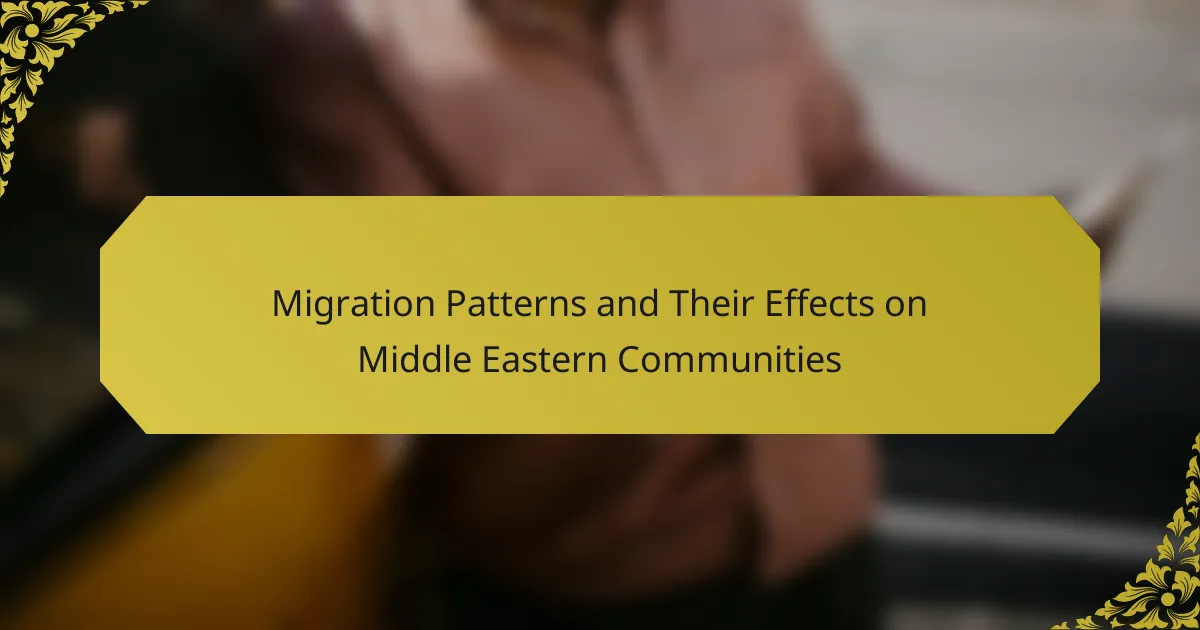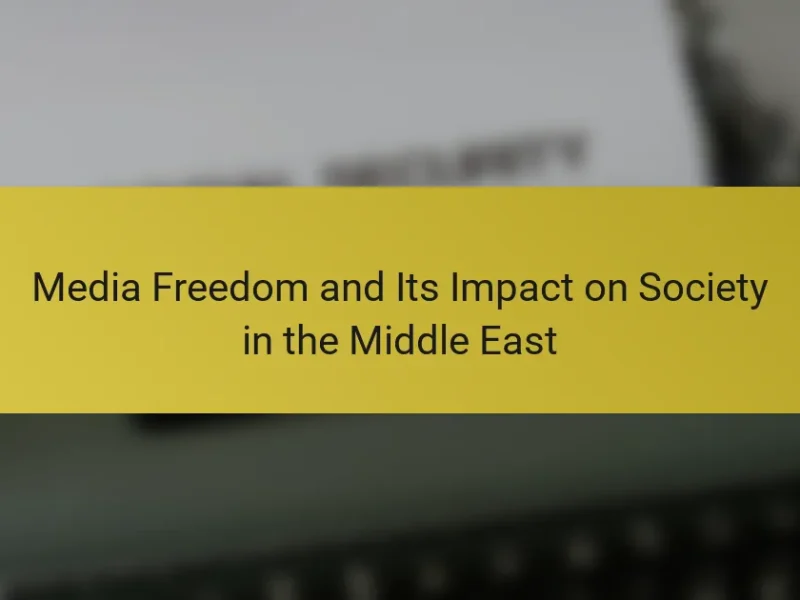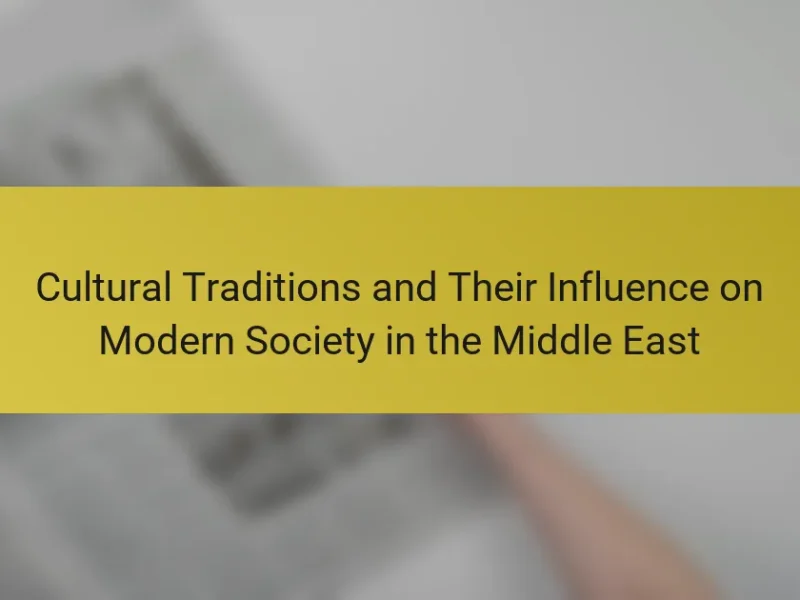
What are Migration Patterns in the Middle East?
Migration patterns in the Middle East involve movements of people due to various factors. These factors include conflict, economic opportunities, and environmental changes. For instance, the Syrian civil war has led to millions of Syrians migrating to neighboring countries and Europe. Economic migration is also significant, with many individuals seeking better job prospects in Gulf Cooperation Council (GCC) countries. Additionally, climate change impacts, such as drought, have prompted rural populations to move to urban areas. According to the United Nations, over 30 million people in the Middle East are currently displaced due to conflict and instability. These migration patterns profoundly affect social dynamics and economic conditions in both host and origin communities.
How do migration patterns develop in Middle Eastern countries?
Migration patterns in Middle Eastern countries develop due to a combination of economic, social, and political factors. Economic opportunities attract individuals seeking better livelihoods. For instance, oil-rich nations like Saudi Arabia and the UAE draw workers from various countries. Social factors, such as family reunification and educational pursuits, also influence migration. Political instability and conflict, particularly in Syria and Iraq, lead to forced displacement. According to the UNHCR, millions have fled these regions seeking safety and stability. Thus, migration patterns are shaped by a complex interplay of push and pull factors, reflecting the unique socio-economic landscape of the Middle East.
What historical factors influence migration trends in the region?
Historical factors influencing migration trends in the Middle East include conflict, economic opportunities, and colonial legacies. Ongoing conflicts, such as the Syrian Civil War, have resulted in millions of refugees seeking safety. Economic disparities drive individuals to migrate for better job prospects, particularly in wealthier Gulf states. Colonial histories have shaped borders and ethnic divisions, prompting movements for autonomy and better living conditions. Additionally, historical trade routes facilitated earlier migrations, influencing current demographic patterns. Each of these factors plays a critical role in shaping the migration landscape in the region.
How do socio-political conditions affect migration patterns?
Socio-political conditions significantly influence migration patterns. Factors such as conflict, political instability, and economic opportunities drive individuals to migrate. For instance, civil wars and oppressive regimes often lead to increased refugee flows. According to the United Nations High Commissioner for Refugees, over 26 million people were displaced due to conflict in 2021. Economic disparities also play a crucial role. Countries with better job prospects attract migrants seeking improved living standards. Historical events, like the Arab Spring, have reshaped migration trends in the Middle East. In summary, socio-political conditions directly affect the motivations and destinations of migrants.
What types of migration are observed in Middle Eastern communities?
Middle Eastern communities experience several types of migration. These include internal migration, where individuals move within their own country, often from rural to urban areas. External migration occurs when people leave their home country for another nation, frequently in search of better economic opportunities or safety. Refugee migration is a significant aspect as many flee conflict or persecution, particularly in war-torn regions like Syria and Iraq. Labor migration is also prevalent, with many seeking work in Gulf countries. Each type of migration reflects distinct socio-economic and political factors influencing the region.
What are the differences between voluntary and forced migration?
Voluntary migration occurs when individuals choose to relocate for reasons such as better employment or education. In contrast, forced migration happens when individuals are compelled to leave their homes due to factors like conflict, persecution, or natural disasters. Voluntary migrants often have the freedom to select their destination and timing. Forced migrants typically have limited options and must leave quickly for safety. According to the United Nations High Commissioner for Refugees (UNHCR), over 26 million people were forcibly displaced worldwide in 2020. This data highlights the significant scale of forced migration compared to voluntary migration, which is less documented but includes millions seeking improved living conditions.
How does internal migration differ from international migration in the region?
Internal migration involves movement within a country’s borders, while international migration entails crossing national boundaries. Internal migration in the region often results from economic opportunities or conflict displacement. For instance, many individuals relocate from rural areas to urban centers seeking jobs. In contrast, international migration may be driven by factors such as seeking asylum or better living conditions. The scale of internal migration is typically larger, as it affects more individuals within a nation. According to the United Nations, internal migration in the Middle East has been significant due to ongoing conflicts. International migration, however, often involves fewer individuals but can have more profound impacts on host countries.
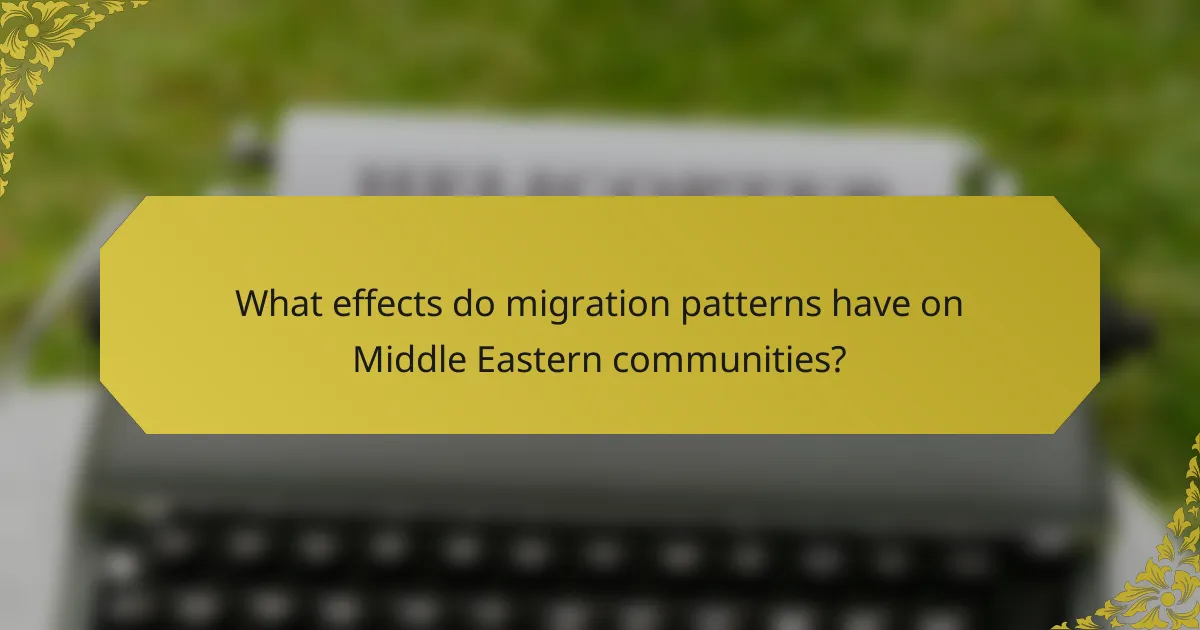
What effects do migration patterns have on Middle Eastern communities?
Migration patterns significantly affect Middle Eastern communities by altering demographics, economies, and social structures. Increased migration leads to a diverse cultural landscape. This diversity can foster innovation and economic growth. However, it may also create tensions between different cultural groups. Economic impacts include remittances sent back home, which support local economies. Additionally, migration can lead to brain drain in countries of origin. Socially, migration can strain public services in host communities. Overall, migration reshapes the identity and dynamics of Middle Eastern societies.
How does migration impact the economy of these communities?
Migration positively impacts the economy of Middle Eastern communities by increasing labor supply and stimulating demand for goods and services. Migrants often fill labor shortages in various sectors, contributing to economic growth. They also bring diverse skills that enhance productivity and innovation. Additionally, remittances from migrants support local economies by increasing household income. According to the World Bank, remittances to Middle Eastern countries reached $53 billion in 2020, significantly boosting local consumption. Furthermore, migration can lead to investment in infrastructure and public services, as increased population density often prompts government initiatives. Overall, migration serves as a catalyst for economic development in these communities.
What are the economic benefits of migration for host communities?
Migration provides significant economic benefits for host communities. It often leads to increased labor supply, filling gaps in various sectors. Migrants contribute to local economies by spending on goods and services. This spending stimulates demand, creating jobs for both migrants and locals. Furthermore, migrants often bring diverse skills that enhance productivity. Research from the World Bank indicates that migration can boost GDP growth in host countries. In the Middle East, remittances from migrants support local economies and improve living standards. Overall, migration fosters economic dynamism and resilience in host communities.
How does remittance inflow from migrants affect local economies?
Remittance inflow from migrants positively affects local economies. It increases household income, enabling families to spend more on goods and services. This spending stimulates local businesses and creates job opportunities. According to the World Bank, global remittances reached $540 billion in 2020, significantly impacting developing countries. In many Middle Eastern communities, remittances account for a substantial portion of GDP. This financial support can enhance education and healthcare access, improving overall community well-being. Additionally, remittances can lead to infrastructure development, as families invest in housing and local projects.
What social changes occur due to migration in the Middle East?
Migration in the Middle East leads to significant social changes. One major change is the increase in cultural diversity. Migrants bring different customs, languages, and traditions. This diversity can enhance social interactions and community dynamics.
Another change is the shift in labor markets. Migrants often fill labor shortages in various sectors. This can lead to economic growth and changes in employment patterns.
Additionally, migration impacts social structures. Family units may be altered as individuals move for work. This can affect traditional roles and relationships within families.
Moreover, migration can lead to social tensions. Host communities may feel threatened by the influx of newcomers. This can result in conflicts or discrimination against migrants.
Finally, migration influences education systems. Increased demand for education services may arise. Schools might need to adapt to accommodate diverse student populations.
These social changes reflect the complex interplay between migration and community dynamics in the Middle East.
How does migration affect cultural diversity in Middle Eastern communities?
Migration enhances cultural diversity in Middle Eastern communities by introducing new traditions, languages, and customs. It fosters the exchange of ideas and practices among diverse groups. This interaction can lead to a richer cultural tapestry. For instance, the influx of refugees has brought various cultural expressions into host nations. According to the UNHCR, over 5 million Syrians have migrated since 2011, significantly influencing local cultures. Additionally, remittances from migrants often support cultural events and initiatives in their home communities. This blending of cultures can promote tolerance and understanding among different ethnic groups.
What challenges do migrants face in integrating into local societies?
Migrants face numerous challenges in integrating into local societies. Language barriers significantly hinder communication and social interaction. Cultural differences can lead to misunderstandings and social isolation. Economic factors, such as limited job opportunities, restrict financial stability. Legal issues, including lack of documentation, complicate access to services. Discrimination may result in social exclusion and reduced opportunities. Additionally, emotional stress from displacement can impact mental health. These challenges collectively impede successful integration into host communities.
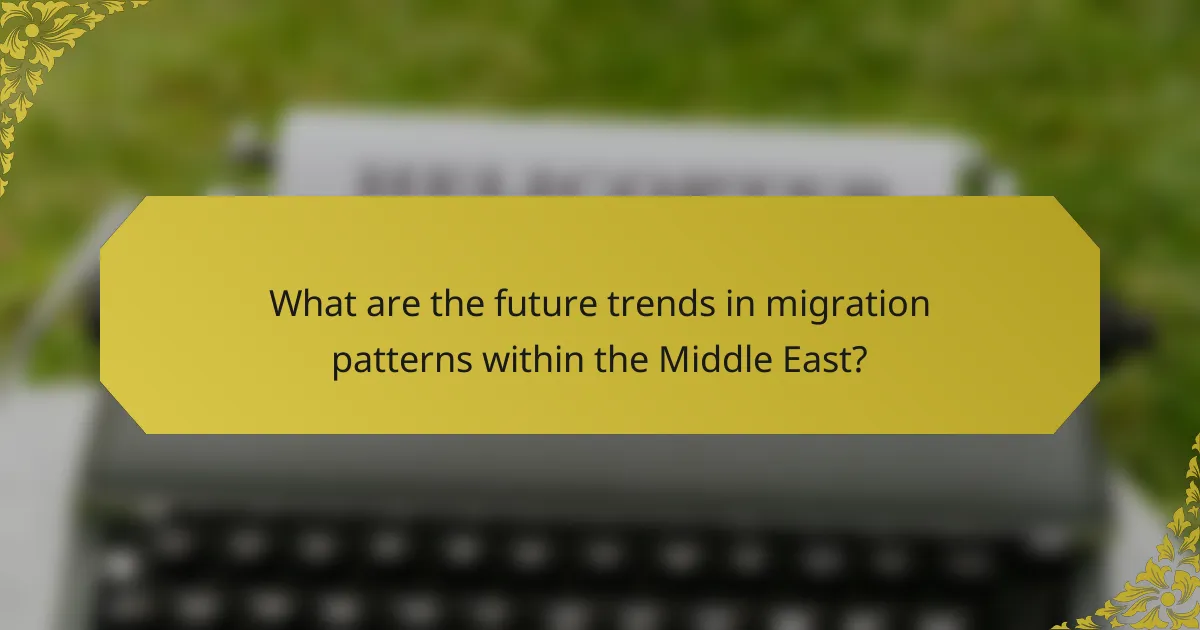
What are the future trends in migration patterns within the Middle East?
Future trends in migration patterns within the Middle East indicate increased urbanization and labor migration. Many individuals are moving from rural areas to cities for better economic opportunities. Countries like the UAE and Qatar are expected to attract more foreign workers due to ongoing infrastructure projects. Political instability in regions like Syria and Yemen continues to drive refugees to neighboring countries. Climate change may also influence migration, with people relocating from areas affected by environmental degradation. Additionally, intra-regional migration is likely to rise as individuals seek stability in less volatile neighboring states. The demographic shifts will affect labor markets and social services in host countries. These trends are supported by reports from the International Organization for Migration and the United Nations.
How might climate change influence migration in the region?
Climate change may significantly influence migration patterns in the region. Rising temperatures and extreme weather events can lead to resource scarcity. Water shortages and declining agricultural productivity may force communities to relocate. For example, the World Bank projects that climate change could displace over 140 million people in developing countries by 2050. In the Middle East, increased droughts and desertification are already impacting livelihoods. This situation can drive internal migration from rural areas to urban centers. Additionally, cross-border migration may increase as people seek more stable environments. These factors collectively highlight the link between climate change and migration trends in the region.
What role does urbanization play in future migration trends?
Urbanization significantly influences future migration trends by driving people from rural areas to cities. Urban centers often provide better job opportunities, healthcare, and education. This trend is evident in regions like the Middle East, where rapid urbanization is occurring. According to the United Nations, urbanization in the Middle East is projected to reach 80% by 2050. This shift leads to increased internal migration as individuals seek improved living conditions. Additionally, urbanization can create economic hubs, attracting international migrants. The concentration of resources and services in urban areas further accelerates this migration trend.
What strategies can communities adopt to manage migration effectively?
Communities can adopt several strategies to manage migration effectively. First, they can implement inclusive policies that support integration. These policies may include access to education, healthcare, and employment opportunities for migrants. Second, communities can foster dialogue between migrants and local residents. This helps build understanding and reduces tensions. Third, establishing local support networks can provide migrants with essential resources. These networks can include cultural orientation programs and legal assistance. Fourth, data collection on migration trends can inform policymakers. This allows for evidence-based decisions that address community needs. Lastly, collaboration with NGOs can enhance support services. NGOs often have expertise in migration issues and can help communities respond effectively.
How can local governments support migrant integration?
Local governments can support migrant integration by implementing inclusive policies and programs. They can establish community centers that offer language classes and cultural orientation. These centers can also provide legal assistance and job training programs tailored for migrants. Local governments should foster partnerships with NGOs to enhance resource availability. They can also promote social cohesion through community events that celebrate cultural diversity. Data from the International Organization for Migration indicates that such initiatives significantly improve integration outcomes. Local governments play a crucial role in creating an environment where migrants feel welcomed and supported.
What best practices can be implemented to enhance community resilience?
Best practices to enhance community resilience include fostering social networks and encouraging community engagement. Strong social ties enable support during crises. Training community members in emergency preparedness builds capacity. Regular drills and workshops improve readiness for disasters. Diverse economic opportunities create stability and reduce vulnerability. Access to mental health resources supports emotional well-being. Collaboration with local organizations strengthens resource sharing. Investing in infrastructure enhances adaptability to change. Research shows that communities with strong networks recover faster from disruptions.
Migration patterns in the Middle East encompass the movement of people driven by factors such as conflict, economic opportunities, and environmental changes. The article explores how these patterns develop within the region, influenced by socio-political conditions and historical contexts. It examines various types of migration, including voluntary, forced, internal, and international migration, and their effects on local economies and social structures. Additionally, the article highlights future trends influenced by urbanization and climate change, providing strategies for communities to effectively manage migration and support integration efforts.
